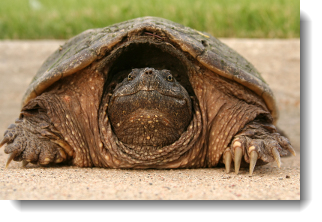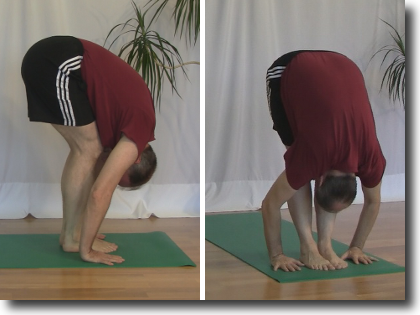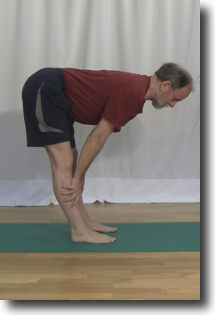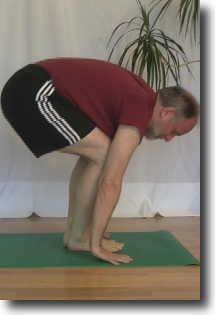Bob is struggling to get his hands to the floor in Uttanasana. His head has almost disappeared into his shoulders. His shoulder blades are a long way down towards his ears in his attempt to get his hands flat to the floor beside his feet. He looks an awful lot like a turtle.
Later Bob is complaining about how sore his neck and upper back are.
There are a couple of things that Bob can do to avoid the turtle effect and enjoy Uttanasana more.
What is Uttanasana
Uttanasana is the sanskrit name for a standing forward fold. Uttanasana (pronounced OOT-tan-AHS-ahna) means intense stretch. This is one of the poses in the Sun Salute Series. It occurs near the beginning and the end of the series. Uttanasana can also be done as a stand alone pose.
Uttanasana calms the brain and helps relieve stress and mild depression. It also stimulates the liver and kidneys while it stretches the hamstrings, calves, and hips. This standing forward fold strengthens the thighs and knees as it reduces fatigue and anxiety.
Uttanasana is a straight forward pose to do. There is no binding of the arms, and no twisting of the torso.
How to do Uttanasana
You start in Tadasana, standing tall with your legs straight and your big toes touching. If you are doing a Sun Salute your arms are raised up over your head. If you are doing Uttanasana by itself your arms are by your side.
From here you engage Uddiyana Bandha (your lower abdominal muscles) and as you exhale, bring the top of your hips forward and down. This brings your torso forward and down as well.
Draw your head in towards your shins and lower your hands to the floor beside your feet. Spread your fingers wide and let your thumbs almost touch the side of your feet.
Direct your gaze down your nose and hold this position for several breaths.
As you can see this is a very easy pose to do. However you can injure your neck muscles in this pose if you are not careful.
How can you injure your neck in Uttanasana
You can injure your neck muscles when you bring your arms towards your floor beside your feet.
Attempting to reach your hands to the floor before your body is ready will result in your shoulder blades rising up towards your ears. This will result in the turtle effect.
This lifting of the shoulder blades causes stress and tension to build up in your neck and upper back muscles. Too much of this stress and tension can result in injury to your neck and upper back.
Why do you injure your neck
There are a two reasons why you injure your neck in this pose.
1. Your Ego
You see your teacher and several people around you doing the pose and getting their hands flat to the floor beside their feet. You feel compelled to do the pose as well as the people around you. Your ego is pushing you to keep up. You do not want to be left behind. You want to be seen as good as everyone else is. So as a result you ignore the limitations of your body and push yourself into the pose.
2. You ignore feedback from the body
The second thing that happens is that you ignore what your body is telling you. Your hamstrings and hips are telling you that you can not go any further into the pose.
In your desire to do the pose to the same extent as your teacher, you ignore this feedback and you reach with your arms and push your hands to the floor. To compound matters even further, you ignore the feedback from your body once again as you lift your shoulder blades towards your ears in order to get your hands on the floor.
There are a few things that you can do to avoid injuring your neck.
How to avoid the turtle effect
There are two things you can do in this pose to protect your neck and upper back and avoid the turtle effect.
1. Accept where you are at
One of the most difficult thing for a person new to yoga to learn is accepting the limitations that their body is placing on them when they attempt to do a pose. Their current flexibility will limit how well they can do a particular pose. Learning to accept this limitation and work within the limits that their flexibility has placed on them is a very important lesson that yoga is teaching them.
Unfortunately it takes about six months for a person new to yoga to learn this less
on and accept where they are at in a particular pose. Once this lesson is learnt, their yoga practice will become much more satisfying and safer.
2. Modify the pose
Once you have learnt to accept the limitations of your body’s ability to do a pose then you need to learn the appropriate modifications to the pose. These modifications work with your body’s current flexibility while protecting you from injuring yourself.
Rather than pushing your hands to the floor in Uttanasana and injuring your neck and upper back, you can bring your hands to your shins and keep your shoulders away from your ears.
Pay attention to the feedback from your neck and shoulders as you move your hands toward the floor. When you feel your shoulder blades start to lift and the tension building in your neck muscles it is time to bring your hands to your legs. Do not put your hands directly on your knees.
But you want to get your hands on the floor
There is a modification that you can do that will permit you to get your hands on the floor beside your feet without injuring your neck and upper back.
As you fold forward into Uttanasana bend your knees and bring your hips closer to the floor. Keep bending your knees and lowering your hips until you can comfortably put your hands on the floor beside your feet.
Once you have your hands on the floor, you can start to very slowly straighten your legs and lift your hips. It is very important at this point to pay close attention to the feedback from your body and in particular your neck and upper back muscles. Stop straightening your legs when you start to feel your shoulder blades moving towards your ears.
You want to comfortably challenge your body in the pose, but you do not want to cause injury. Just go as far into the pose as you feel comfortable.
Summary
Uttanasana is a very simple pose to do. Your legs are straight and you lower your torso towards your legs and bring your hands to the floor beside your feet. However you can injure your neck and upper back if you try to go beyond the flexibility limits of your body.
There are some things that you can do in the pose to avoid injuring your neck and upper back:
- Learn to accept the limits that your body places on you in a yoga pose. This is an important lesson that your yoga practice is teaching you. It takes a lot of time to learn this lesson.
- Pay attention to the feedback from the body and work within the limitations of your body.
- Modify the pose to work within the flexibility of your body by either putting your hands on your legs or bending your legs and lowering your hips towards the floor.
Honor the feedback from your body and accept where you are in the pose. And like a turtle that is relaxed, keep your head and neck extended out of your shell.
Next steps
Work with your teacher to make sure that you are not injuring your neck and upper back muscles in Uttanasana.
Additional reading
Learn how to avoid injuring your lower back by reading the article How to avoid hanging basket injuries in Uttanasana.
Follow the Filbert Principle and you will move steadily and safely towards your goal.
Read How to pick up your newspaper: try these standing forward bends to learn a couple more forward bends.







